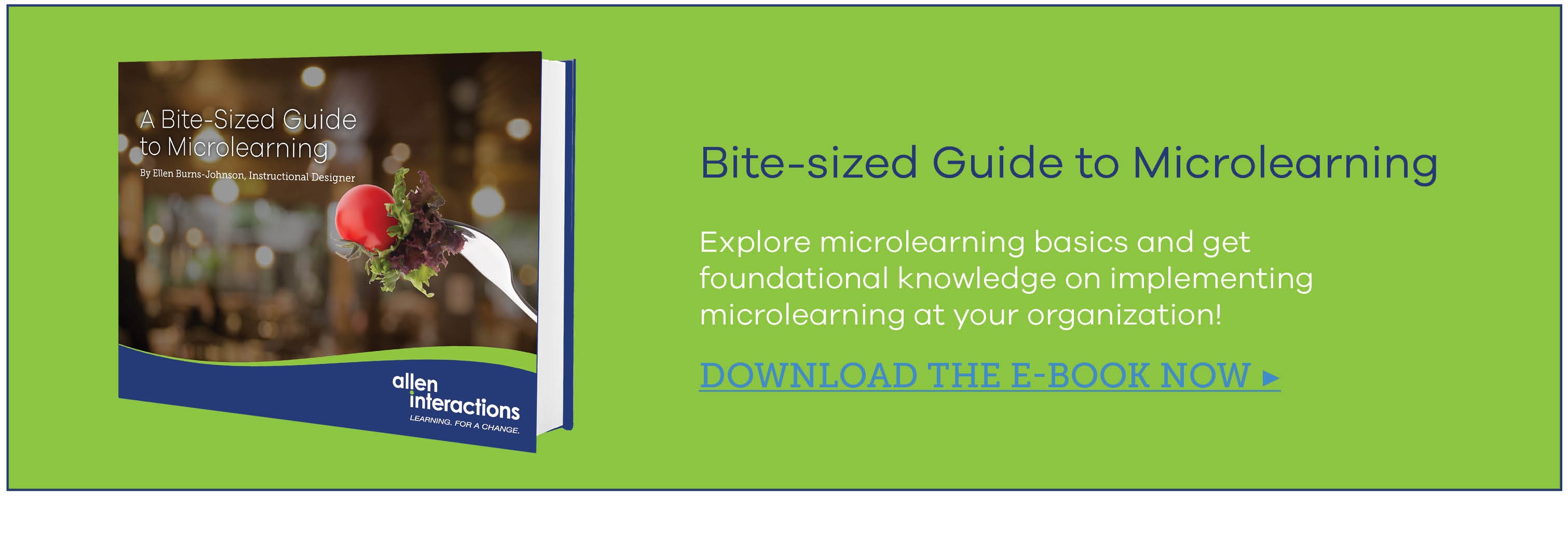Blog
Get Inspired: Five Examples of Good Microlearning Design
By Ellen Burns-Johnson, Instructional Designer / @ellenbjohnson Last week, my Studio Executive and I visited a client in California. The meeting went ...

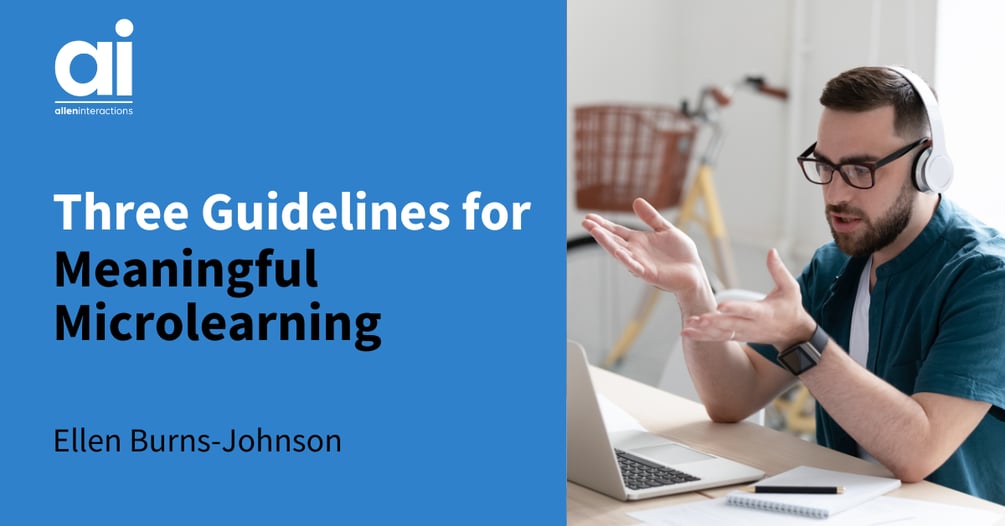
Three Guidelines for Meaningful Microlearning
By Ellen Burns-Johnson | March 28, 2017 | Custom Learning | 0 Comments
.png?width=166&name=Ellen(250).png) By Ellen Burns-Johnson, Instructional Designer / @ellenbjohnson
By Ellen Burns-Johnson, Instructional Designer / @ellenbjohnson

I loved the food. Each dish was its own experience, thoughtfully prepared, the flavors balanced so that each bite made an impact. I can get tired of bigger dishes after several minutes of experiencing the same flavors again and again. Not with this food. After devouring the mojama, I took a few bites of morcilla cebolla, then moved onto queso con fresas al vapor. Yum.
I think that eating tapas is a good metaphor for high-quality microlearning. Tapas aren’t created by taking a large dish, chopping it up into small pieces, and delivering them to the table one or two at a time. There’s a lot more thought that goes into the experience.
Nevertheless, microlearning is often discussed simply as a means of delivering learning content in small bites that are easier for today’s “distracted” learners to consume. Inherent in these discussions seems to be the assumption that learners will be better off if we can just make learning experiences shorter and easier to get through. By that logic, the best way to consume a cheeseburger would be to grind it up in a blender and slurp it down in a glass. Gross!
Just because microlearning is smaller or easier to digest doesn’t mean it’s better for learning. In this post, I’ll offer three principles to help you design short-yet-meaningful experiences for your learners.
1. Clearly define the performance goals.
Microlearning is becoming increasingly synonymous with “mobile.” Some organizations hope that, by making content shorter and more accessible, learners will be more willing to engage with material that the organization perceives as valuable.
Yet, it doesn’t matter how short or accessible microlearning is if learners don’t perceive it as meaningful. It has to really, truly help them get better at something they care about. Find out what learners need and design for that.
Finding the right performance goal is tough. As with any training initiative, you’ll want to pinpoint the skills that are most critical to the job so that your material has the most impact. However, be careful not to underestimate the complexity of someone else’s job. Most jobs require hundreds of skills, and learners need to be competent in executing them under various conditions. Microlearning can help introduce new skills incrementally, reinforce these skills over time, and give learners the opportunity to practice the same skills under different circumstances.
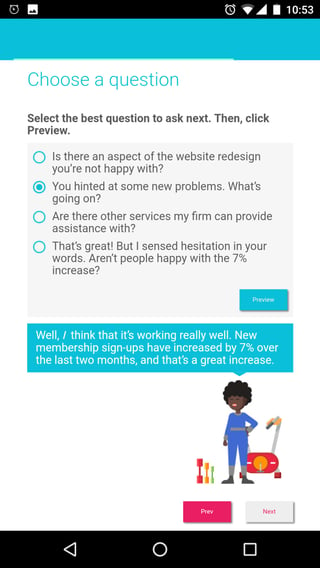
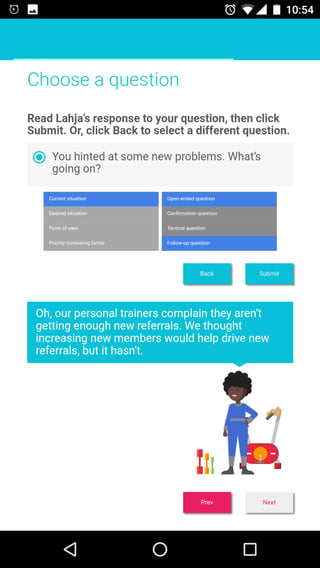
Mobile microlearning can and should haven an element of challenge.
2. Completion doesn’t (necessarily) result in skill.
Another common topic in discussions about microlearning is the idea of motivation. The idea is that learners will be more motivated to complete microlearning courses because they’re short, and unlike classroom training and some elearning courses, learners decide when and where to complete them.
If microlearning helps motivate learners to complete content, that’s great, but that doesn’t necessarily indicate that the content actually helps learners to get better at their jobs.
To explore this idea, let’s say I want to be a chef at a local restaurant. If I tell the manager that I’ve memorized 300 recipes, the manager might be impressed. Would the manager hand over the kitchen to me? Of course not, because I wouldn’t have demonstrated that I can actually do the job. Being a chef requires so much more than memorizing recipes—it requires cooperation with staff, coordinating meal preparation, determining the quality of the ingredients, and much more.
So it is with microlearning. Just because people read about doing something and complete a quiz about doing it, doesn’t mean they can actually do it. Even if they believe they can do it, they still might be wrong.
If your organization does a good job of tracking performance metrics, you can look at those metrics to evaluate how effective your learning is. Unfortunately, such metrics often aren’t readily available or simply don’t exist. Learning designers then have to rely upon quizzes (which measure knowledge, but not performance) or surveys, which are subjective.
At Allen Interactions, we try to solve this problem by designing the performance right into the learning experience. The interaction in the GIF below only takes a few minutes to complete and requires learners to find security threats in an office. Because the exercise closely resembles what they’ll have to do in real life, learners are highly likely to transfer the skill from the learning environment to the work environment.
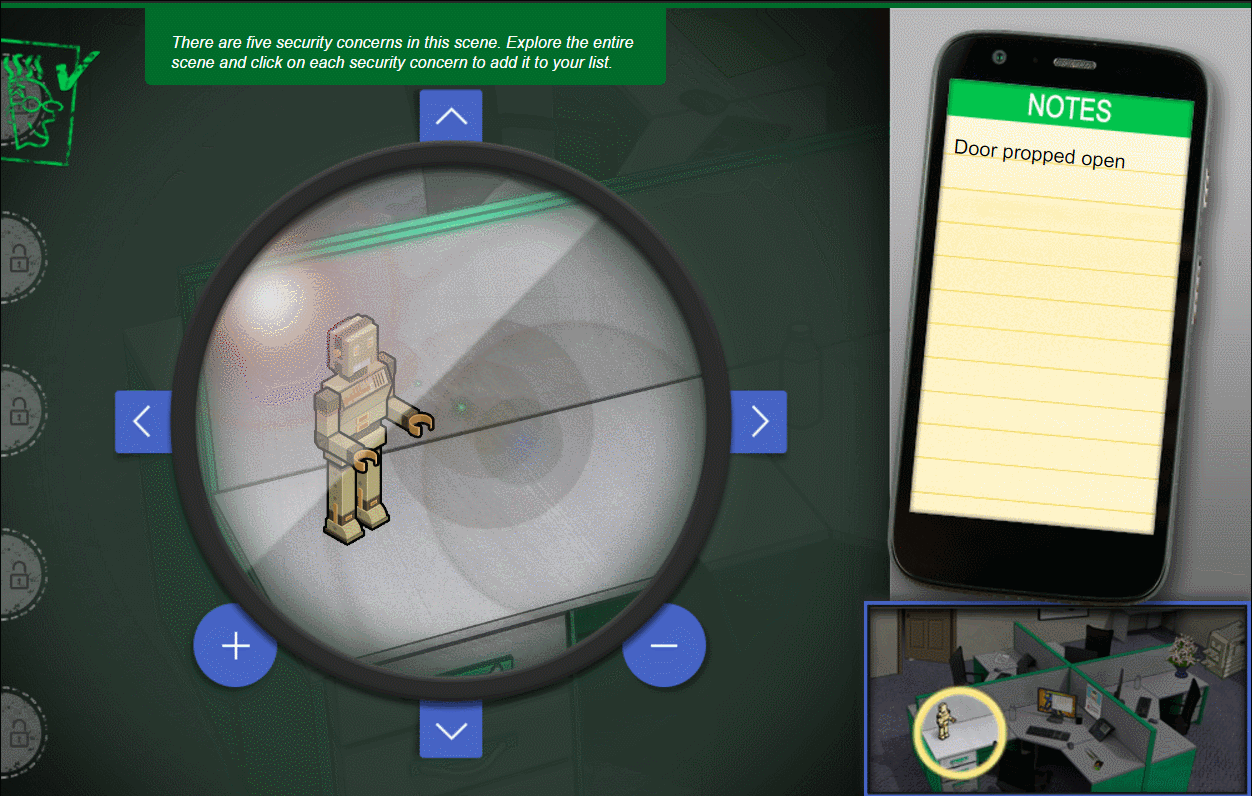
3. Be flexible.
Go to any downtown area and you’ll find a plethora of different restaurants, serving dozens of different types of cuisine. Some are as casual as a backyard barbecue, and others might have valet parking. Choosing the best among them depends on your meal preferences and what type of experience you want to have.
Just like your dinner options, there’s no “one right way” with microlearning. Different philosophies, platforms, and modalities can be used to create experiences that are fairly called microlearning. Some of these experiences are between five and ten minutes long. Others strive to get content down to under two minutes. Some tout video as the best medium, while others focus on minigames.
Personally, I think the best microlearning is focused (one topic or scenario), short (under ten minutes), and preferably multi-platform (desktop/tablet and mobile). However, I also think it’s OK to break my own rules in the service of good learning design.
For example, when a client needed to rebuild their entire new-hire curriculum so that it could be delivered online, we recommended webinars and self-guided exercises along with microlearning-style scenarios and simulations. Yet, none of it was designed for smartphones. Due to security reasons, employees would always be doing their jobs at a company-issued laptop, so there was no need to invest the extra design and user testing efforts that would be needed to create quality mobile content.
Ultimately, you’re in charge of the kitchen. Do what’s best for your learners. Maybe that means investing in an entire engagement platform, but it could also take the form of a handful of elearning mini-modules, a series of short videos, or a custom learning app.
Just make sure it’s good and tasty.
(In case you’re wondering, the restaurant we visited was Viva Madrid in Claremont, California.)
More Resources on Microlearning:
SHARE THIS BLOG:
Click to Tweet: New #aiblog from @ellenbjohnson offers three principles to design short-yet-meaningful #microlearning experiences https://ctt.ec/7Rpl0+ @customlearning

About the Author: Ellen Burns-Johnson
Ellen Burns-Johnson has over a decade of experience in the education and training industries. She has crafted the instructional strategy and design for dozens of major initiatives across diverse topics, from classroom safety to IT sales. Emphasizing collaboration and playfulness in her approach to creating learning experiences, Ellen’s work has earned multiple industry awards for interactivity and game-based design. Ellen is also a Certified Scrum Master® and strives to bring the principles of Agile to life in the L&D field. Whether a client is a Fortune 100 company or a local nonprofit, she believes that the best learning experiences are created through processes built on transparency between sponsors and developers, empirical processes, and respect for learners. Outside of her LXD work, Ellen plays video games (and sometimes makes them) and runs around the Twin Cities with her two mischievous dogs (ask for pictures).
Comments
Would you like to leave a comment?
Related Blog Posts

By: Ellen Burns-Johnson | Sep, 2015
Category: Custom Learning

Blog
Microlearning: Overcoming 4 Assumptions
By Ellen Burns-Johnson, Instructional Designer / @ellenbjohnson Last week, my Studio Executive and I visited a client in California. The meeting went ...
By: Ellen Burns-Johnson | Jun, 2017
Category: Custom Learning

Blog
Three Things You Don't Need in Your Microlearning Video
By Ellen Burns-Johnson, Instructional Designer / @ellenbjohnson Last week, my Studio Executive and I visited a client in California. The meeting went ...
By: Ellen Burns-Johnson | Dec, 2015
Category: Custom Learning

